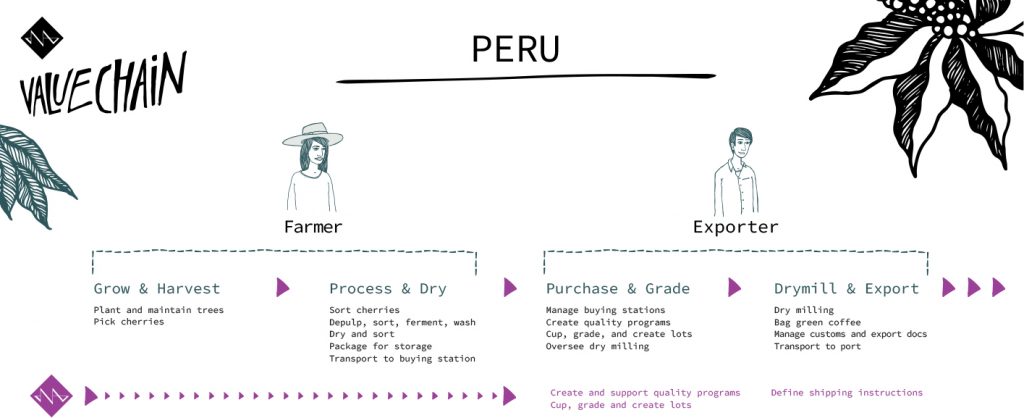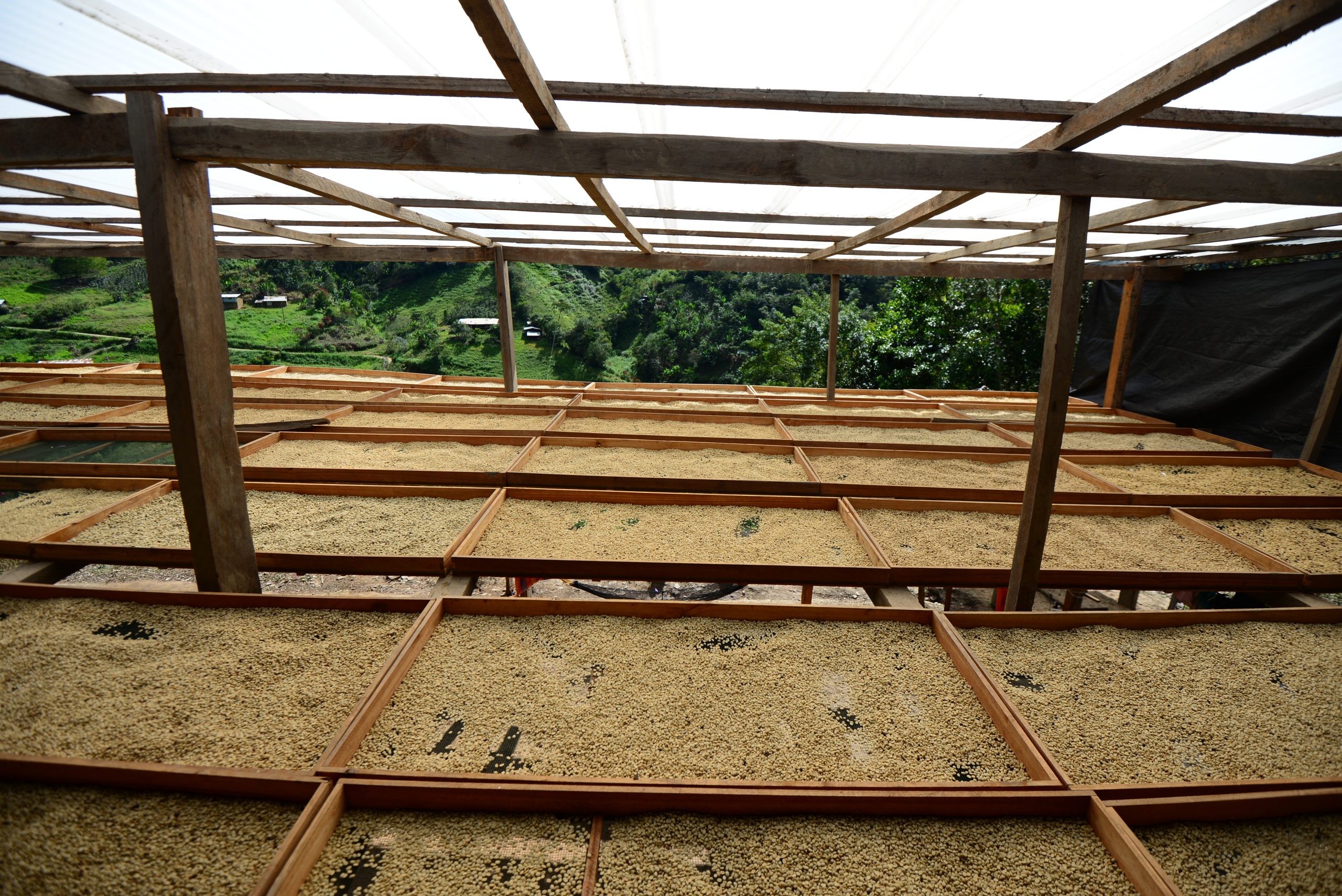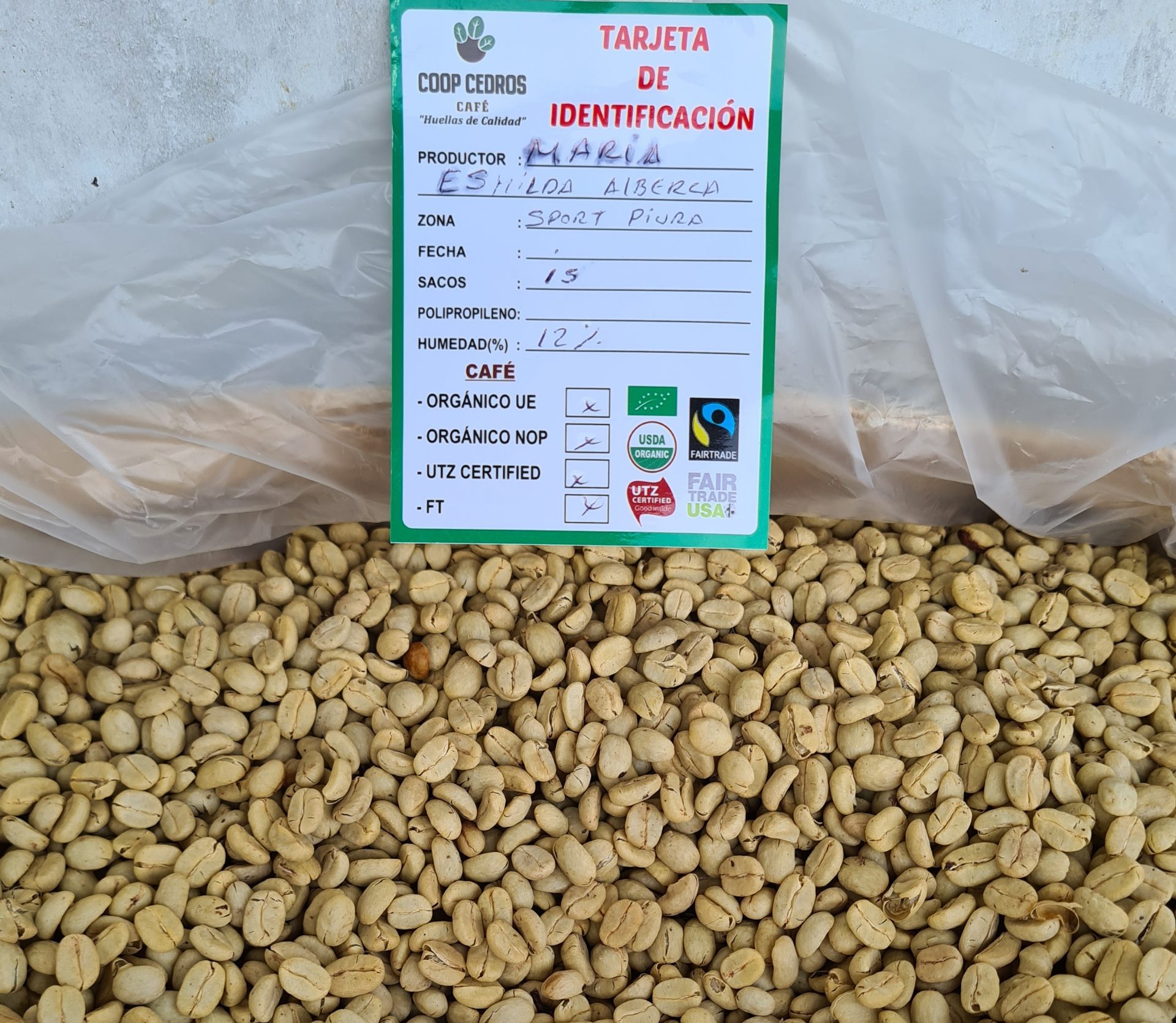Our sourcing strategy
Peru is an origin with enormous potential for quality, but it is better known for certified coffees at extremely low prices. We aim to incentivise quality in this origin by creating quality programs in small communities, building good quality protocols, full traceability, and solid premiums for our producers.
The cup profiles
Jammy fruit, layers of perfumed florals, with great structure and complexity.
The value chain
Farmers are typically smallholders with around 2-5 hectares of farmland. Coffees are usually processed at small micro mills on the farm. Farmers deliver parchment to exporters or cooperatives who cup and grade the coffee, dry mill and export green coffee.

The relationships
We are amazed by the potential in Peru. With simple equipment, minimal infrastructure and hardly any governmental support, farmers can produce amazing coffees. Many of the greatest coffees we have tasted have come from producers with a small hand-pulper, a wooden tank for dry fermentation and plastic on the ground for drying. Sadly most of these quality lots go into a big pile which is sold for an extremely low price. Producers are not paid for quality so their investment in improving quality is minimal. Fortunately things are changing.
There are a few private exporters and organisations that are active in promoting better premiums for good quality. We have decided to work in the north of Peru for now, around Jaen and San Ignacio in Cajamarca. We have developed programs with small communities in a few selected areas through a privately owned company called Origin Coffee Lab. Plus we are exploring other projects, including one with a small cooperative called Cedros.
We select micro-lots of the high performing coffees at lot sizes between 10 – 20 bags. Additionally we create blends from the same communities where the coffees are exceptional but the lots are too small to buy individually. As always we pay high premiums for quality, well above the local price, and still the coffees are extremely good value for the quality.
The challenge
Peru is known for cheap, certified organic and Fair Trade coffees in the low to medium quality range. This is partially because coffees are randomly blended. The way the coffee is traded in Peru offers little incentive for producers to invest in quality. And yet there is a lot of coffee around and the quality potential is great.
Cooperatives exist all over the country and they are very strong in the Peruvian coffee sector. Most of them are specialised in selling certified coffees. Some work in the specialty area but they mainly offer coffees scoring 80-84 points, and producers do not benefit from specialty premiums.
The low prices the producers earn make coffee financially unviable, so many coffee farmers are giving up on coffee and switching to other crops, like coca, an illegal crop that is the raw material for cocaine. Fortunately some cooperatives and young exporters are focused on building the specialty segment by creating quality programs that teach producers how to improve the cup quality, and reward them financially for their investment. These are the partners working with in Peru.
Background info
There are ten growing regions in Peru. The regions we see with most potential for quality are Cajamarca and Amazonas in the north, Junin in what they call the Central Jungle, and Cusco and Puno in the south. Cajamarca is the biggest producing region. Here you can find farms at altitudes above 2000 masl but higher is not always better. There are plenty of great coffees being grown at 1600 and you can find gems at even lower elevations.
Some say that coffee growing in Peru started in the Central Jungle, others say it began in the north. There were growers of German and Italian descent that were farming coffee in the 1800’s. Many of the growers currently working in the Cajamarca came from the Piura region (in the west) in the 1950s and 1960s.
The main focus until recently was certification, be it organic, Fairtrade or UTZ. Coffees are still mainly sold in bigger chunks of commercial and high commercial qualities, up to 84 points, at really low prices. For many this is unsustainable. In Puno, for example, production has dropped from 180000 bags to 8000 bags because of leaf rust and the low C-price. Several cooperatives went bankrupt, and many coffee producers switched to coca production. It is easier to grow, and more profitable, and there are always ready buyers for this raw material of cocaine.
Varieties
Many of the producers in the medium to low altitudes grows strains of Catimor. At higher altitudes you start to see different varieties, the most common being Bourbon, Costa Rica (a Bourbon type), Red and Yellow Caturra, Typica, Pache (a dwarf Typica), and occasionally Catuai in the north. Typica is the main variety in the south. Many farmers have begun to plant Geisha.
Planting and production
The majority of the coffees are organic, which is great. The general spacing is 2 x 1 metres which allows for around 5000 trees per hectare. Yields are often low however, around 1 tonne per hectare or less, or 500 grams of greens per tree. Farmers apply compost, and those who can afford it apply organic fertilizers. Organic farmers who manage their farms well can achieve up to three times to average yield. Conventional producers using chemical fertilisers have a massive production by local standards.
Processing
Post-harvest production (processing) is the biggest challenge for quality. The coffees are mainly processed at small micro-mills on the farms with very limited resources. There are a few more advanced setups around, with improved pulpers, fermenting tanks and solar dryers in the Colombian style. There are also producer groups and associations with small communal washing stations for processing, and some bigger washing stations under construction.
At a glance
Average farm size:
2 hectares
Harvest season:
May – October
Process:
Mostly washed, processing is done on the farms in micro-mills
Fermentation:
Mainly dry fermented in small wood or concrete tanks.
Drying:
On plastic on the ground, on rooftops, and in parabolic dryers. A few producers use tables or African beds.
Altitudes:
1600 – 2000 masl
Varieties:
Bourbon, Typica, Caturra, Catuai, Pache, Costa Rica, Catimor. Small quantities of Geisha.
Peru Videos:
Peru Blog Posts:

Navigating Coffee Sourcing in Peru
We had the pleasure of sitting down with Joanne Berry, Head of Sourcing & Procurement at Tropiq, and Gabe Dunn, EU Sales Manager at Nordic Approach. They both recently returned from Peru, where they had the chance to meet with a number of producers and suppliers right at the source. […]

Concept coffees for our value-added blends
Why do we create concept coffees? As a key part of our work, we are always looking for ways to add value within the supply chains we work in and to the production of coffee by creating quality programs in small communities. For this reason, we develop concept coffees in […]

The unspoken treasures of Peruvian coffee. What do these coffees taste like?
Personally, I try to avoid restricting the taste profile of Peruvian coffee to only one definition, since we’re used to encountering so many different profiles… Enki SuarezQuality Coordinator, Tropiq Already well-recognized for its gastronomy, chocolate and landscapes, we’re more interested in sharing one of the other unspoken treasures of Peru. […]
Peru Offers
Go to our full offer list to see loyalty discount prices.
